calsfoundation@cals.org
Mammoth Spring (Fulton County)
| Latitude and Longitude: | 36º29’44″N 091º32’27″W |
| Elevation: | 528 feet |
| Area: | 1.29 square miles (2020 Census) |
| Population: | 929 (2020 Census) |
| Incorporation Date: | June 15, 1889 |
Historical Population as per the U.S. Census:
|
1810 |
1820 |
1830 |
1840 |
1850 |
1860 |
1870 |
1880 |
1890 |
1900 |
|
– |
– |
– |
– |
– |
– |
– |
– |
– |
717 |
|
1910 |
1920 |
1930 |
1940 |
1950 |
1960 |
1970 |
1980 |
1990 |
2000 |
|
817 |
700 |
600 |
666 |
870 |
825 |
1,072 |
1,158 |
1,097 |
1,147 |
|
2010 |
2020 | ||||||||
|
977 |
929 |
Located at the head of the Spring River on the Arkansas-Missouri border, the city of Mammoth Spring (Fulton County) has always depended upon the large, naturally flowing spring of the same name for its existence. The town started as a railroad stop, bringing visitors and much needed goods to Fulton County during the late nineteenth and early twentieth centuries. Mammoth Spring residents also harnessed the strong current of the Spring River to bring electricity and industrialization to the Ozark foothills. Although the factories are gone and the train depot is now a museum, Mammoth Spring continues to attract new citizens and tourists.
Pre-European Exploration through the Civil War
Despite the attempts of modern researchers to dive into the waters, little has been discerned about the geophysical origins of the spring, which releases nine million gallons of water per hour. Geologists and other scientists believe that the spring is a release valve for a complex underground river system. According to folklore, when an Indian chief attempted to bury his son, a warrior who had died looking for water, the spring sprung from the earth and saved the tribe from devastation. Between the time of the Louisiana Purchase and the Civil War, trappers and settlers referred to the site as the “Head of the Waters.” The original village site had been established long before in Missouri, near what was called the Harry Turnstall spring, known today as “Old Town.” Settlers did make homesteads around the spring, but section lines split the spring into four different forty-acre plots. No one person owned the spring before the railroads were built. William Allen and Bill Mills established farms and built gristmills at the spring in the 1850s. Historians and Civil War enthusiasts believe the first phase of the Action at Spring River was fought near the spring on the Arkansas side where Mammoth Spring is located today.
Post Reconstruction through Early Twentieth Century
Mammoth Spring emerged in 1883 when what later became the Frisco railroad extended track from Springfield, Missouri, to Memphis, Tennessee. The railroad company bought a piece of land located between the spring and the river from the Dearthridge family, thought to be Irish Catholic, and there built the station and depot. According to local historian Vester Williams, the railroad developers realized a bridge would be needed; the town was hence moved from Missouri to Arkansas. This same bridge is also Dam No. 1, which was destroyed by floods in 1915, rebuilt later that decade, and eventually made part of the Mammoth Spring State Park. Once the railroad was established, people immigrated to the new town looking for economic opportunities through business, farming, and industry. Napoleon Hill, a Memphis native who promoted the town economically and industrially, also founded the first school in 1888. The Mammoth Spring Improvement Company built two more dams further down the Spring River, and in 1927, Mammoth Spring became the first town in the region to have electricity, which was powered through the dams.
Only the dams on the Spring River remain as testimonies to industrialization, as the enterprises to pass through Mammoth Spring failed to find long-term success. From the 1880s to the 1920s, Mammoth Spring had a textile mill, a shoe manufacturing plant, and a soda bottling factory. Calumet Cotton Factory was the major employer in 1889 and was described “as a 2-story brick textile mill with 120 looms, 5000 spindles, and 150 employees.” According to historian Brooks Blevins, this factory was “a rare representative of this southern industry in the Ozarks.” The Chanticleer Packing Company, a poultry processing plant, opened during the Great Depression and provided jobs for Mammoth Spring and Fulton County residents until 1956.
More importantly, the tourist industry also began in the 1880s. In 1889, the first large hotel, the Nettleton, was built, and the Culp Hotel and Charlton Hotel soon followed. Like Eureka Springs (Carroll County) and Hot Springs (Garland County), Mammoth Spring profited from the health crazes of the late nineteenth century, which recommended bathing in hot natural springs as a cure for a host of physical ailments. While the spring and the Spring River, which stays a constant fifty-eight degrees year-round, could not be marketed as a health resort, Memphis residents often vacationed in the town during the summer months. Finding the climate of the Ozark town to be much cooler than the Delta region, they built large homes on the bluffs overlooking the river.
World War II through the Modern Era
When the Frisco railroad stopped carrying passenger cars in 1968, Mammoth Spring changed from a dynamic railroad stop to an idyllic community. Tourists were already arriving by car instead of train, and the fishing industry came to play a much larger role. In the 1970s, the old train depot was converted into a museum, and the spring area was preserved as a state park. Mammoth Spring continues today to preserve its historic downtown with shops and restaurants for visitors, while maintaining an elementary school and a high school for local residents.
Mammoth Spring has also shaped American culture through music and film. The founder of the Grand Ole Opry, George D. Hay, traveled through the area in 1919. Hay, also known as the 1920s radio personality the “Solemn Old Judge,” collected songs, anecdotes, and stories during this trip, which also included a visit to Mammoth Spring. Actress Tess Harper grew up in Mammoth Spring and graduated from high school there in 1968.
Attractions
Mammoth Spring is known for its state park and the Mammoth Spring National Fish Hatchery, which raises trout. Its easy access to the Spring River encourages canoeing and fishing. Mammoth Spring also continues to hold a century-old festival every year in August. The Soldiers, Sailors, and Marines Reunion began as a tribute to Civil War veterans in 1890 and was called the “Blue and Gray Reunion” for many years. Mammoth Spring also holds a Solemn Old Judge Days festival on Labor Day weekend in honor of George D. Hay.
Notable Figures
James Robinson Risner was a fighter pilot famed for his resistance as a prisoner during the Vietnam War.
Blevins, Brooks. Hill Folks: A History of Arkansas Ozarkers and Their Image. Chapel Hill: University of North Carolina, 2003.
Fulton County, Arkansas: History and Families. Morley, MO: Acclaim Press, 2008.
Goodspeed’s History of Northeast Arkansas. Chicago: Goodspeed Publishing Co., 1889.
History of Fulton County. Compiled by Dorothy A. Brinker. Norman, OK: 1972.
Jackson, Dave, and Jo Nicholson. “Mammoth Spring or ‘Head of the River.’” In Fulton County History Book. Morley, MO: Acclaim Press, 2008.
Pace, Jean, Joan Simers, and Norma Swope. “Mammoth Spring.” Fulton County Chronicle 1 (Winter 1982): 30–36.
Zeigler, Wes. “Mammoth Spring: A Little Town with Lot of History.” Arkansas Democrat Magazine, May 24, 1987, pp. 8–11.
Sarah E. Simers
University of Arkansas, Fayetteville
 Salmonids
Salmonids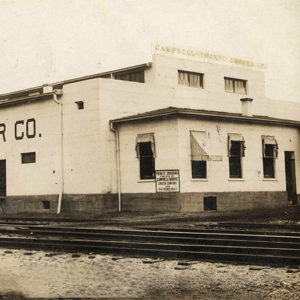 Campbell-Thorpe Grocer
Campbell-Thorpe Grocer 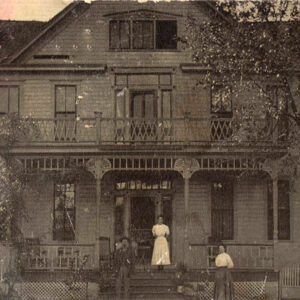 Culp Hotel
Culp Hotel  Fulton County Map
Fulton County Map  Tess Harper
Tess Harper 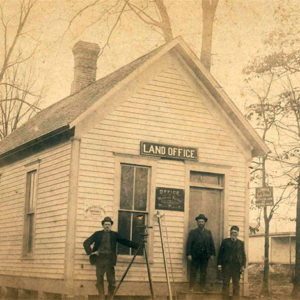 Land Office
Land Office 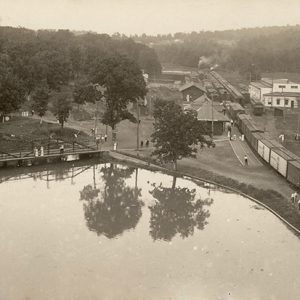 Mammoth Spring Depot
Mammoth Spring Depot  Mammoth Spring National Fish Hatchery Ponds
Mammoth Spring National Fish Hatchery Ponds  Mammoth Spring National Fish Hatchery
Mammoth Spring National Fish Hatchery 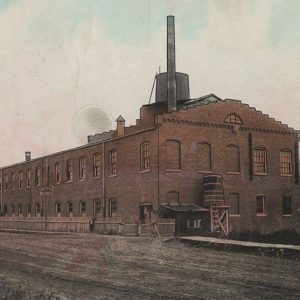 Mammoth Spring Shoe Plant
Mammoth Spring Shoe Plant  Mammoth Spring
Mammoth Spring 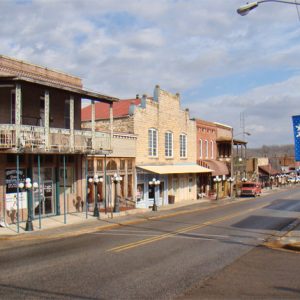 Mammoth Spring Street Scene
Mammoth Spring Street Scene  Mammoth Spring Street Scene
Mammoth Spring Street Scene 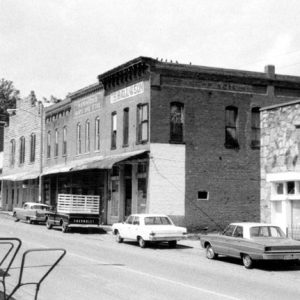 Mammoth Spring Street Scene
Mammoth Spring Street Scene  Mammoth Spring Street Scene
Mammoth Spring Street Scene  Mammoth Spring Train Depot
Mammoth Spring Train Depot 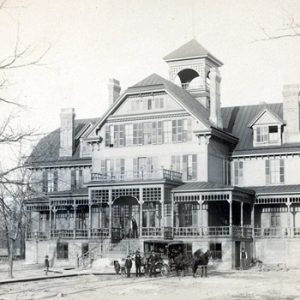 Nettleton Hotel
Nettleton Hotel 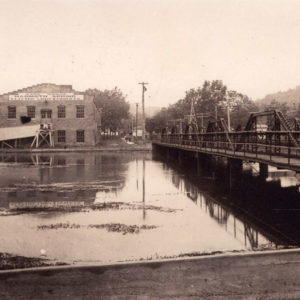 Spring River Bridge
Spring River Bridge 




This is a large beautiful spring. One can walk over the dam. Feed the ducks. The town is like it was in 1950. No modern stores on Main Street. Two nice eating places down from the dam and you can watch the waters flow over the dam. The best fried catfish is at Fred Fish House. One can buy catfish off dam #9. Cannot wait for my next vacation for exploring the Ozarks.